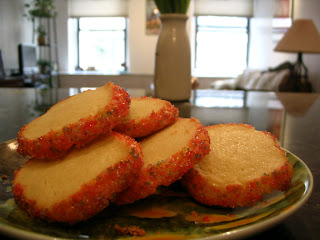 I love fried chicken, but I just don't see myself making it often: I'm not Southern and don't have a recipe from my mom, plus it's messy, a tad unhealthy, etc. But what I can see myself making often is this fabulous chicken dish from Mario Batali's soon-to-be-published book Italian Grill. Make no mistake: this is not fried chicken. But it's a spectacular alternative, crunchy and flavorful and extremely tasty.
I love fried chicken, but I just don't see myself making it often: I'm not Southern and don't have a recipe from my mom, plus it's messy, a tad unhealthy, etc. But what I can see myself making often is this fabulous chicken dish from Mario Batali's soon-to-be-published book Italian Grill. Make no mistake: this is not fried chicken. But it's a spectacular alternative, crunchy and flavorful and extremely tasty.To make Chicken Thighs with Snap Peas and Agliata, you coat boneless, skinless chicken thighs with a garlicky bread crumb mixture and cook it slowly over a low grill so, says Mario, "you end up with juicy meat and toasted herbed crust." I initially balked at the "boneless, skinless" suggestion, since in my experience that is the least tasty kind of chicken you can buy. But thighs are juicier, and one I read the recipe through, I realized that if you did use chicken with skin, the breadcrumbs would stick to the skin and slide right off when you cut into the meat. Instead, what winds up happening is the bread crumbs themselves form a sort of skin over the chicken. The meat stays really moist, and the crumbs toast up so nicely.
The secret ingredient here is anchovies, and as some readers know, I have a tenuous relationship with the hairy little fishes. But trust me, in this dish, they work perfectly. There's not a grain of salt in the entire dish (snap peas included); it's just not necessary once you blend in three (or four) anchovies to the bread crumb mixture and spoon a dollop of anchovy paste into the hot olive oil that will coat the beans.
I can't wait to try this recipe on a real grill this summer.--S
Chicken Thighs with Snap Peas and Agliata
Serves 6
12 garlic cloves, crushed
3/4 c extra-virgin olive oil
2 salt-packed anchovies, filleted, rinsed, and patted dry, or 4 oil-packed fillets, drained
1/2 c chopped fresh Italian parsley
2 c fresh bread crumbs
12 boneless, skinless chicken thighs
4 shallots, sliced 1/4" thick
1 t anchovy paste
1 lb sugar snap peas
1. Combine the garlic, 1/2 c of the oil, the anchovies, parsley, and bread crumbs in a food processor and zap until smoothish.
2. Put the chicken thighs in a large bowl and sprinkle with the bread crumb mixture, turning to coat well. Arrange in a single layer on a platter and put in the refrigerator for 15 minutes.
3. Bring a large pot of water to a boil. Set up an ice bath. Drop the snap peas into the water and cook just until bright green, about 1 minute. Drain, plunge into the ice bath to cool, and drain again. Set aside.
4. Prepare a gas or charcoal grill for indirect grilling. [Or heat your grill pan to medium heat.]
5. Place the chicken thighs skinned side up on the cooler part of the grill, cover the grill, and grill, turning once, until the chicken is cooked through, about 15 minutes per side.
6. Meanwhile, heat the remaining 1/4-c. oil in a 10" to 12" saute pan over medium heat. Add the shallots and anchovy paste and cook, stirring occasionally, until the shallots are soft, about 5 minutes. Add the snap peas and cook, stirring, just until heated through. Transfer the snap peas to a platter.
7. Arrange the thighs on top of the snap peas and serve.
Recipe courtesy of Italian Grill












